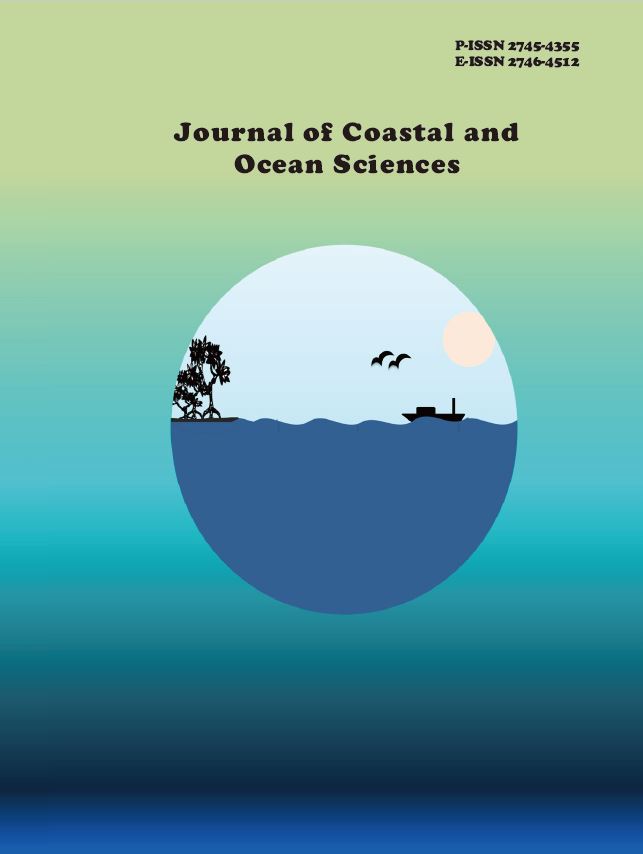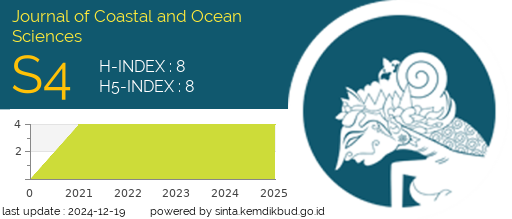Abundance and Diversity of Sponges in the Waters of Pasumpahan Island, West Sumatra
DOI:
https://doi.org/10.31258/jocos.6.2.119-124Keywords:
Sponges, diversity, abundance, Pasumpahan IslandAbstract
Sponges are the most primitive multicellular animals that live in various types of waters, ranging from fresh to brackish and marine. Sponges live at the bottom of the water, usually embedding themselves in rigid substrates such as rocks or corals and competing with other attached organisms for food space. This study aimed to analyse the abundance and diversity and determine the differences in sponge abundance at different depths. This research was conducted in March 2024 in Pasumpahan Island, West Sumatra. This research used the survey method and the belt transect method. The sampling location was divided into three stations consisting of 3 sampling points. Station I is located in the tourist area, Station II is in the dock area, and Station III is in the area facing the open sea. The results showed that the highest abundance based on depth was found at station I with a depth of 5 m, namely 1071.4 ind / ha and the lowest abundance at station II with a depth of 7 m, 714.286 ind / ha. The t-test results obtained a significant value of less than 0.05, namely 0.048, which means that the abundance of sponges at different depths is significantly different. The diversity index ranges from 1.930 to 2.013, indicating that the sponge diversity level in Pasumpahan Island waters is classified as moderate. The T-test results show a significant value of more than 0.05, namely 0.795, which means the abundance of sponges at two depths is significantly different
Downloads
References
[KLH] Kementerian Negara Lingkungan Hidup. (2004). Keputusan Menteri Lingkungan Hidup Nomor 51 Tahun 2004 Tentang Baku Mutu Air Laut. Jakarta. 10 p. Retrieved April 17, 2025
Adamimawar, C.N.I., Jailani, A.Q., & Aji, M.T. (2022). Study on Potential Feasibility of Aquaculture Land Using Geographic Information System (GIS) in North Semarang Sea. Asian Journal of Aquatic Sciences, 5(2): 249-256.
Alfiah, A. (2023). Kontribusi Pengembangan Wisata Bahari Dalam Peningkatan Pendapatan Masyarakat Sekitar Pulau Karampuang Kabupaten Mamuju. IAIN Parepare. 104 p.
Ananda, N.N., Efriyeldi, E., & Thamrin, T. (2019). Species Diversity and Distribution of Sponges in the Coastal Area of Kasiak Island, Pariaman Regency, Sumatera Barat Province. Asian Journal of Aquatic Sciences, 2(2): 162-169.
Arisandi, A., Badrud, T., & Fauzan, A. (2018). Coral Reef Profile of Kangean Island, Sumenep District, Indonesia. Jurnal Ilmiah Perikanan dan Kelautan, 10(2): 76-83.
As-Syakur, A.R., & Wiyanto, D.B. (2016). Studi Kondisi Hidrologis sebagai Lokasi Penempatan Terumbu Buatan di Perairan Tanjung Benoa Bali. Jurnal Kelautan: Indonesian Journal of Marine Science and Technology, 9(1): 85-92.
Azis, R. (2023). Struktur Komunitas Makrozoobentos Epifauna pada Ekosistem Mangrove di Desa Bulu Cindea, Kecamatan Bungoro, Kabupaten Pangkep. Universitas Hasanuddin. 38 hlm.
Fidayat, F., Lestari, F., & Nugraha, A.H. (2021). Keanekaragaman Spons pada Ekosistem Padang Lamun di Perairan Malang Rapat, Kabupaten Bintan. Jurnal Akuatiklestari, 4(2): 71-83.
Krebs, C.J. (1989). Ecological Methodology. Second Edition. New York: An Imprint of the Addition Wesley Longman. 237 p.
Manzanaris, M.R., Rondonuwu, A.B., & Pratasik, S.B. (2018). Struktur Komunitas dan Kondisi Terumbu Karang di Perairan Desa Poopoh Kecamatan Tombariri Kabupaten Minahasa. J. Ilmiah Platax, 7(1): 9-19.
Muqsit, A., Purnama, D., & Ta’alidin, Z. (2016). Struktur Komunitas Terumbu Karang di Pulau Dua Kecamatan Enggano Kabupaten Bengkulu Utara. Jurnal Enggano, 1(1): 75-87.
Nayyiroh, D.Z., & Muhsoni, F.F. (2022). Evaluasi Kondisi Terumbu Karang di Pulau Gili Labak Kabupaten Sumenep. Juvenil: Jurnal Ilmiah Kelautan dan Perikanan, 3(4): 125-133.
Odum, E.P. (1996). Dasar-dasar Ekologi; Edisi Ketiga.Yogyakarta. Gadjah Mada University Press, Penerjemah Samingan, Tjahjono.
Ompi, B.N., Rembet, U.N., & Rondonuwu, A.B. (2019). Coral Reef Conditions of Hogow and Dakokayu Islands, Southeast Minahasa Regency. Jurnal Ilmiah Platax, 7(1): 186-192.
Prasetia, I.N.D. (2012). Rekrutmen Karang di Kawasan Wisata Lovina. JST (Jurnal Sains dan Teknologi), 1(2): 61-72.
Purnama, A.A. (2013). Struktur Komunitas Karang di Perairan Pulau Pasumpahan. Edu Research, 2(2): 103-110.
Rinanda, R. (2021). Analisis Aktivitas Radionuklida 14c Pada Karang Favia Stelligira di Pulau Satando Kepulauan Spermonde Menggunakan Metode Lsc (Liquid Scintillation Counting). Universitas Hasanuddin. 31 p.
Riyantini, I., Harahap, S.A., Kostaman, A.N., Aufaadhiyaa, P.A., Yuniarti, M.S., Zallesa, S., & Faizal, I. (2023). Kelimpahan, Keanekaragaman dan Distribusi Ikan Karang dan Megabentos Serta Hubungannya dengan Kondisi Terumbu Karang dan Kualitas Perairan di Gosong Pramuka, Taman Nasional Kepulauan Seribu. Buletin Oseanografi Marina, 12(2): 179-191.
Sari, L. N., & Aunurohim, A. (2013). Korelasi Komunitas Nudibranchia dengan Komunitas Porifera di Perairan Pasir Putih, Situbondo. Jurnal Sains dan Seni ITS, 2(2): 224-229.
Sofarini, D., Aminah, S., Hidayah, R.N., & Hanifa, M.S. (2021). Keterkaitan Kualitas Air dengan Keanekaragaman Zooplankton di Sungai Barito Kecamatan Marabahan Kabupaten Barito Kuala. Rekayasa, 14(3): 421-430
Downloads
Published
Issue
Section
License
Copyright (c) 2025 Muhammad Rusdi, Efriyeldi Efriyeldi, Thamrin Thamrin (Author)

This work is licensed under a Creative Commons Attribution 4.0 International License.





